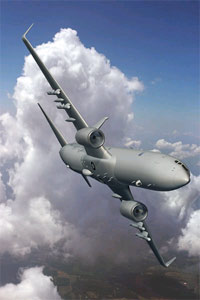J
John
Guest
Yes we are getting the real thing and nothing downgraded, matter of fact HAL/TATAs etc will also get sub-contracting work for the P-8 as well.will they give what usa ordered or degrade p8i for india
P-8's Advanced Radar Could Be Electronic Weapon
Raytheon won a multi-year contract from the U.S. Navy to develop an Advanced Airborne Sensor for the P-8A. It will be a follow-on to the conventional, mechanically-scanned Littoral Surveillance Radar System (LSRS) on initial production aircraft.
The AAS radar is expected to provide more-precise targeting, but Navy officials still won't confirm that it will have an active electronically scanned array (AESA) advanced antenna. They do admit that the P-8 was designed with the 50% extra electrical (180 kva., plus 27,000 lb. of engine thrust), cooling and computing power and room for 12-tons of growth that could support an AESA design. An AESA can increase radar detection range by 2-3 times over a mechanically scanned radar.
The P-8A’s initial APY-10 radar has a range of about 200-mi. with no air-to-air mode. It provides navigation, surface search, periscope detection, ISAR, SAR and weather mode options. It does not have cruise missile detection capability, but it does have the necessary frequency range and antenna size for the mission if the proper software is developed.
Raytheon radar specialists admit they are looking at what they could do to combine AESA radars and larger airframes including an EP-X variant of the P-8A. Available antenna area extends from the electronics bay access door behind the nose wheel to the main landing gear clearance at the aft end – a distance of 43 ft. A 10 ft. antenna, about 40% larger than that carried by the Global Hawk UAV, is at one end of the spectrum. But it still wouldn’t provide small, cruise missile and stealthy aircraft detection at long range. That capability would require a 20-ft. antenna.
Nonetheless, a smaller AESA radar on the P-8A could operate much as those on the F-22 Raptor or F-35 JSF. They have an electronic attack capability that could generate jamming, false targets and electronic damages with pulses of microwaves.
AESA antennas can generate energy pulses of great average power, according to radar specialists. Since a radar has the built-in ability to find and track a target, the beam can be held on the target for the necessary additional microseconds to create a weapons effect on a foe’s electronics. The AESA radar can identify a target, search its internal library for the target’s vulnerable frequencies and then tailor the energy pulse for the specific target.
LSRS is currently operational on Navy P-3C Orions; the AAS will provide airborne radar surveillance with next-generation line-of-site capability and, Navy officials say, to let them deal with the “ever changing threats of tomorrow.”
As the sensor prime contractor, Raytheon will oversee the mission systems integration, consisting of the development, production and installation of the AAS on the Poseidon. Raytheon will work closely with its associate prime contractor, Boeing, for engineering, aircraft modifications, integration and flight test.
Ares Homepage
Spook Radar In Surprise Breakout
The Navy is buying a version of the covertly developed Littoral Surveillance Radar System (LSRS) for the Boeing P-8A Poseidon multi-mission maritime aircrarft (MMA). Release here.
The APS-149 LSRS is an old friend of Ares - covered back in 2007 and readdressed later in the year. It's currently operational on a select group of P-3s.
The new contract for the Advanced Airborne Sensor (AAS) is something of a surprise. Last summer, when a group of reptiles was briefed on the P-8A in Seattle, we asked about LSRS and the potential for the P-8A to move into the overland surveillance mission. However, we got generally bland answers, possibly because we were all focusing on the EP-X follow-on SIGINT aircraft but mainly because the real answer was secret. But a few weeks later, the Navy took steps to give Boeing a contract for integration of the new AAS.
LSRS and AAS are large-aperture, ultra-high-resolution surveillance radars designed for synthetic aperture radar (SAR) and ground moving target indication (GMTI) modes. The "littoral" tag masks the fact that this is mainly a land surveillance radar - the APY-8 in the P-8A's nose copes perfectly well with sea clutter to find and track small maritime targets.
What this means is that the Navy intends to spend real money to move the P-8A into the land-surveillance domain, while the USAF has waffled on whether to start work on updating the aging radar on the E-8C Joint STARS. The 737 is very comparable to the Joint STARS in terms of range and cabin size, but will cost much less to operate.
This is not a new idea, either. As detailed in the linked Ares post, when I asked in 2003 why Boeing had switched from the 737-700 to the -800 as its MMA candidate, I was told it was to provide for "a classified capability" - and our 2007 speculation that it was for LSRS has now been proved correct. The longer fuselage, together with moving the weapons bay aft of the wing, provides a location for the long antenna pod of the AAS.
One question is whether the USN is also committed to meeting the needs of ground commanders. The surveillance and communications capabilities inherent in maritime aircraft have caused them to be in high demand for overland operations. I suspect that an AAS-equipped P-8A won't spend a lot of time chasing submarines, as long as current conflicts continue.
Alert 5





